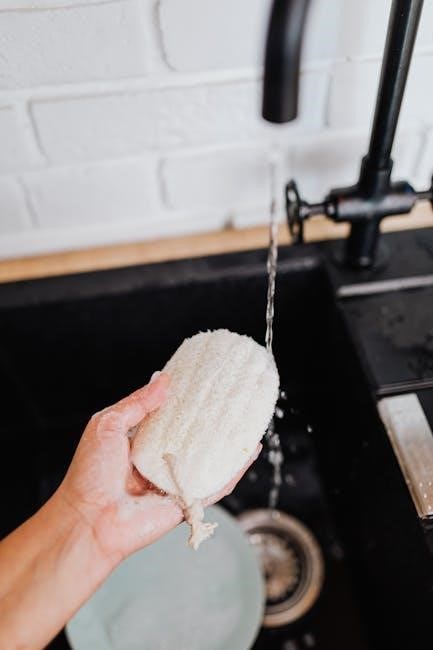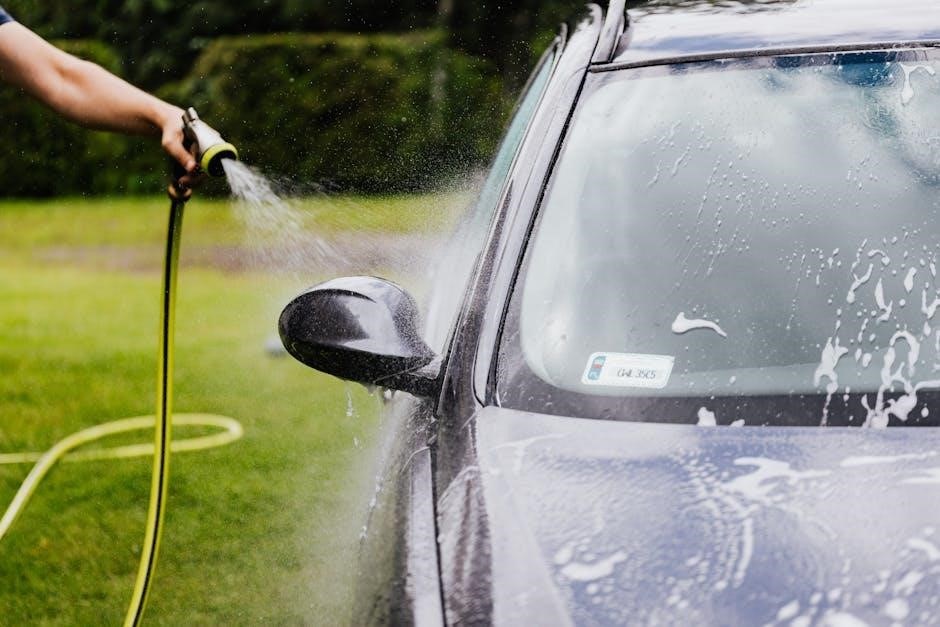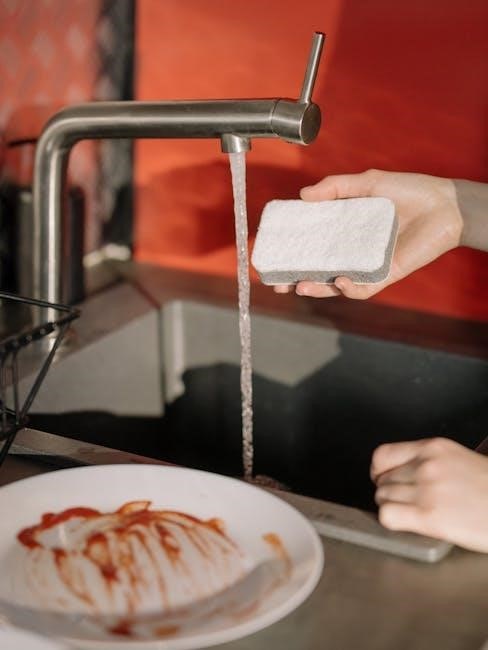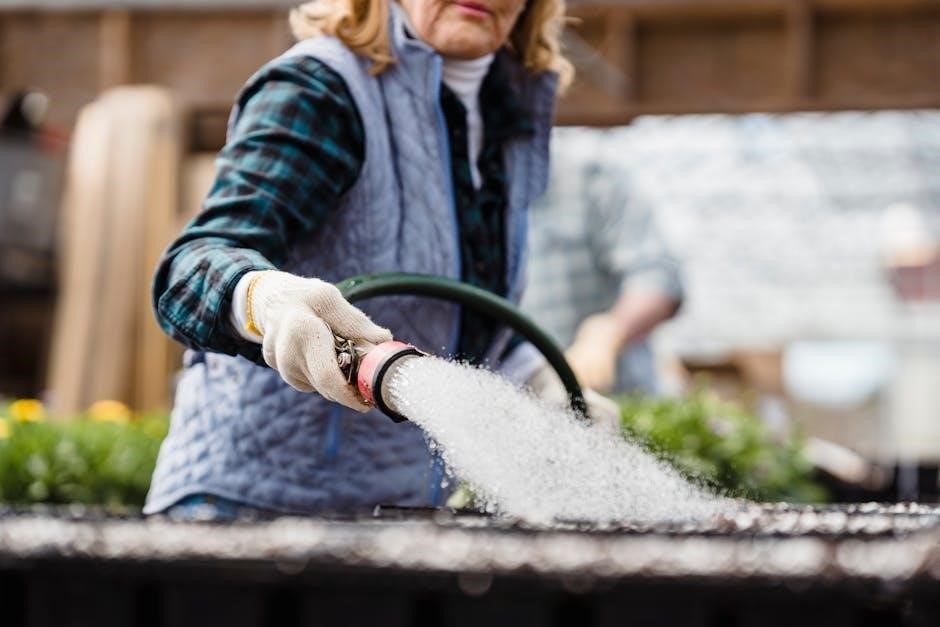Manual water softener regeneration is a process to restore your system’s efficiency by flushing the resin bed with a brine solution‚ removing trapped minerals and ensuring softened water flow.
This method is essential when your water softener isn’t regenerating automatically‚ ensuring optimal performance and preventing hard water issues in your plumbing system.

Understanding the Importance of Regeneration
Regeneration is crucial for maintaining your water softener’s effectiveness; Over time‚ the resin bed in the system becomes saturated with hardness minerals‚ reducing its ability to soften water efficiently. Without proper regeneration‚ these minerals can cause scaling in pipes and appliances‚ leading to reduced water flow and higher energy bills. The process involves flushing the resin bed with a concentrated brine solution‚ which removes trapped minerals and restores the resin’s capacity to soften water. Regular regeneration ensures optimal water quality‚ prevents system damage‚ and extends the lifespan of your water softener. It is essential to follow the correct manual regeneration steps to achieve the best results and maintain soft water throughout your home.
Overview of the Manual Regeneration Process
The manual regeneration process involves initiating a regeneration cycle without relying on an automated system. It typically starts by locating the control valve or regeneration button on your water softener. Holding down the REGEN button for several seconds until the motor begins is a common method to start the cycle. Once activated‚ the system will flush the resin bed with a brine solution‚ displacing hardness minerals and rinsing them out through the drain. This process usually takes about 1-2 hours‚ depending on the system’s size and configuration. Manual regeneration is a straightforward procedure that ensures your water softener continues to function effectively‚ especially if the automatic feature is not working or if you need immediate soft water.

Safety Precautions for Manual Regeneration
Wear protective gloves and goggles to prevent skin and eye irritation. Ensure the workspace is clear‚ well-ventilated‚ and free from obstacles. Avoid ingesting the brine solution and handle heavy components with care to prevent accidents.

Protective Gear and Workplace Safety
Protective gear is essential when manually regenerating a water softener. Wear gloves to handle brine and components safely‚ and goggles to shield eyes from splashes. Ensure the workspace is clear of clutter and tripping hazards to prevent accidents. Proper ventilation is crucial to avoid inhaling dust or fumes. Keep children and pets away to maintain a safe environment. Regularly inspect equipment for wear and tear to prevent leaks or malfunctions. Familiarize yourself with emergency procedures‚ such as eye wash stations‚ in case of accidental exposure. By prioritizing safety‚ you can perform the regeneration process confidently and effectively‚ safeguarding both yourself and your equipment.
Preparing Your Workspace Safely
Before starting manual regeneration‚ ensure your workspace is clean and well-prepared. Clear the area around the water softener to prevent obstacles and tripping hazards. Place the unit on a level‚ stable surface to avoid tipping. Open nearby windows for proper ventilation to prevent the buildup of brine fumes. Cover the floor or surrounding surfaces with drop cloths or towels to protect against spills or leaks. Position a bucket or drain pan under the softener to catch any overflow during the process. Ensure all tools and materials are within easy reach to minimize movement during regeneration. Finally‚ double-check that the workspace is dry to prevent slips and ensure safe access to the system components.

Steps to Prepare for Manual Regeneration

Preparing for manual regeneration involves gathering tools‚ locating components‚ checking salt levels‚ ensuring safety‚ and following system guidelines. Proper preparation ensures smooth process.
Gathering Necessary Materials and Tools
To manually regenerate your water softener‚ gather essential materials and tools. You’ll need water softener salt‚ a clean bucket‚ a wrench or screwdriver for valve adjustments‚ and protective gloves. Ensure you have access to a drain or outlet for flushing. A clean‚ long-handled scoop or cup can help measure and pour salt. If your system requires it‚ have a bypass valve ready to isolate the softener. Keep a flashlight handy for inspecting dark areas like the resin tank. Optionally‚ have a cleaning solution for the brine tank. Always refer to your system’s manual for specific tools recommended by the manufacturer. Having everything ready ensures the process is efficient and avoids delays during regeneration.
Locating the Water Softener Components
Before starting manual regeneration‚ it’s crucial to locate and identify the key components of your water softener system. The resin tank‚ typically the larger tank‚ is where water softening occurs. It’s often positioned near the water supply line. The brine tank‚ usually smaller and adjacent to the resin tank‚ holds the salt solution essential for regeneration. The control valve‚ mounted on top of the resin tank‚ regulates water flow and initiates regeneration cycles. Additional components may include a bypass valve‚ drain line‚ and salt level indicator. Familiarize yourself with their locations to ensure smooth operation. If unsure‚ consult your system’s manual or look for labels on the tanks and valves. Knowing where each part is helps in efficiently managing the regeneration process and troubleshooting if needed.
Checking Salt Levels and Brine Tank Condition
Checking salt levels and the condition of the brine tank is essential before manual regeneration. Begin by inspecting the brine tank to ensure it contains an adequate amount of salt. The salt level should be at least 4-6 inches above the water level; if it’s too low‚ add salt to maintain proper regeneration. Avoid overfilling‚ as this can cause spills or clogs. Next‚ examine the tank for any visible cracks‚ sediment‚ or sludge buildup. Clean out any debris using a scoop or soft brush to prevent contamination. Ensure the salt is free-flowing and not hardened‚ as this can disrupt brine flow; Proper salt levels and a clean brine tank are critical for effective regeneration and soft water quality. Regular checks help maintain system efficiency and prevent issues like poor water softening or high salt usage.

Understanding Your Water Softener Components
Your water softener includes a resin tank‚ control valve‚ and brine tank. These components work together to remove minerals‚ regenerate the system‚ and ensure soft water delivery.
The Role of the Resin Tank
The resin tank is the core component where water softening occurs. It contains resin beads that trap calcium and magnesium ions‚ replacing them with sodium or potassium ions. During normal operation‚ hard water flows through the resin‚ which softens the water. Over time‚ the resin becomes saturated with minerals and loses efficiency. Manual regeneration involves flushing the resin with a brine solution to remove trapped minerals and restore its capacity. The resin tank is essential for maintaining soft water quality‚ and its condition directly impacts the effectiveness of the softening process. Regular maintenance ensures optimal performance and prevents issues like scale buildup in plumbing and appliances. Proper care of the resin tank is crucial for extending the system’s lifespan and ensuring consistent water quality. Understanding its role helps in performing manual regeneration effectively.
Function of the Control Valve
The control valve is a crucial component that regulates water flow and directs the regeneration process. It manages the distribution of water and brine solution during different cycles‚ ensuring proper resin cleaning and replenishment. By manually setting the valve‚ you initiate regeneration‚ backwash‚ brine injection‚ and rinse phases. Proper alignment is essential to prevent contamination and ensure effective mineral removal. Regular inspection and adjustment of the control valve are vital for maintaining optimal water softening performance. Its accurate operation guarantees smooth system functionality and consistent water quality.
Importance of the Brine Tank
The brine tank plays a vital role in the water softening process by storing the salt solution essential for regeneration. During manual regeneration‚ the brine tank supplies the saltwater needed to rinse the resin bed‚ removing trapped minerals like calcium and magnesium. A well-maintained brine tank ensures proper replenishment of the resin‚ guaranteeing soft water production. It also prevents bridging or caking of salt‚ which can disrupt the system’s efficiency. Regular inspection of the brine tank is crucial to ensure it is clean‚ free from debris‚ and contains the correct salt levels. A malfunctioning or poorly maintained brine tank can lead to incomplete regeneration‚ reducing the effectiveness of the water softener and potentially causing hard water issues. Proper brine tank management is essential for consistent system performance and water quality.
The Manual Regeneration Process
Manually regenerating your water softener involves initiating the cycle‚ flushing the resin bed‚ refilling the brine tank‚ and allowing the process to complete successfully‚ ensuring optimal performance and water quality.
Initiating the Regeneration Cycle
To initiate the regeneration cycle manually‚ locate the control valve on your water softener system. Turn it to the “regenerate” or “recharge” position‚ depending on the model. This action switches the system into bypass mode‚ ensuring no water is processed during the cycle. Open the valve slowly to allow water to flow into the resin tank. You may hear gurgling sounds as the system begins flushing the resin bed. Monitor the process to ensure it starts correctly. Some systems may require pressing a button or setting a specific duration for the cycle. Always refer to your user manual for model-specific instructions. Proper initiation ensures the resin bed is cleaned and recharged effectively‚ restoring soft water quality. Regular initiation helps maintain system efficiency and prevents mineral buildup.
Flushing the Resin Bed
Flushing the resin bed is a critical step in manual regeneration‚ removing accumulated minerals and restoring its softening capacity. Start by ensuring the water softener is in bypass mode to prevent water flow during the process. Open the drain valve or initiate the flush cycle‚ depending on your system‚ allowing water to flow through the resin tank. This rinses away hardness minerals trapped in the resin. The flush cycle typically lasts 30 minutes to an hour‚ depending on the system and mineral buildup. Monitor the water flow to ensure it runs clear‚ indicating the resin is clean. Proper flushing ensures the resin regains its ion-exchange efficiency‚ providing soft water. Regular flushing prevents resin degradation and maintains system performance. Always follow the manufacturer’s guidelines for flushing to avoid damaging the resin bed.
Refilling the Brine Tank
After initiating the regeneration cycle‚ the next crucial step is refilling the brine tank with the appropriate amount of salt. Ensure the tank is approximately one-quarter to one-half full of water softener salt‚ avoiding overfilling to prevent spillage. Use high-quality salt recommended by the manufacturer‚ such as solar salt or evaporated salt‚ for optimal performance. If the tank contains old or damp salt‚ clean it out before adding new salt to maintain efficiency. Allow the salt to dissolve naturally; this process typically takes a few hours. Once refilled‚ the brine solution will be ready for the next regeneration cycle. Always follow the manufacturer’s guidelines for the correct salt level and type to ensure proper system function and water softening effectiveness.
Allowing the Cycle to Complete
Once the regeneration cycle is initiated‚ it is essential to allow it to run uninterrupted until completion. The process typically takes 1 to 2 hours‚ depending on the system and water usage. Avoid turning off the water supply or interfering with the softener during this time‚ as it may disrupt the cycle and reduce its effectiveness. Monitor the system to ensure it progresses through all phases‚ including backwashing‚ brine injection‚ and rinsing. You may hear gurgling or clicking sounds‚ which are normal parts of the process. After the cycle finishes‚ the resin bed will be clean‚ and the brine tank will be replenished. Allow the system to return to normal operation before using water again. Completing the cycle ensures optimal water softening performance and extends the lifespan of your water softener.

Maintenance and Aftercare
Regular maintenance ensures your water softener operates efficiently. Clean the brine tank‚ check for leaks‚ and monitor salt levels. Schedule annual professional inspections.
Cleaning the Brine Tank
Cleaning the brine tank is essential for maintaining your water softener’s efficiency. Start by turning off the water supply and power to the system. Drain the tank completely using a valve or pump. Remove the brine well or float assembly for thorough access. Mix 1 gallon of water with 1 cup of bleach or vinegar and pour it into the tank. Let it sit for 30 minutes to loosen debris. Scrub the interior with a soft brush and rinse thoroughly. Refill the tank with water and add the recommended amount of salt. Restart the system and run a manual regeneration cycle to flush out the cleaning solution. Regular brine tank cleaning prevents salt bridges and bacterial growth‚ ensuring optimal performance.
Checking for System Leaks
After manual regeneration‚ inspect the water softener system for leaks to ensure proper function. Start by visually examining all connections‚ hoses‚ and fittings for signs of water droplets or moisture. Pay particular attention to the control valve‚ resin tank‚ and brine tank connections‚ as these are common leak points. Turn off the water supply and place paper towels or a dry cloth around the fittings to detect even minor leaks. If a leak is found‚ tighten the connections or replace worn-out gaskets or O-rings. Additionally‚ check the drain line to ensure it’s functioning correctly and not clogged. Addressing leaks promptly prevents water damage and maintains system efficiency. Regular inspections help prevent major issues from developing over time.
Scheduling Future Maintenance
Regular maintenance is essential to ensure your water softener operates efficiently after manual regeneration. Schedule future regeneration cycles based on your water usage and the system’s capacity. Typically‚ regeneration should occur every 1-2 months‚ but this may vary depending on household demand. Track your water usage patterns to determine the optimal frequency. Additionally‚ plan to inspect the resin and brine tanks every 3-6 months to ensure proper function. Maintain a maintenance log to record regeneration dates‚ salt levels‚ and any repairs. Consistent scheduling helps prevent mineral buildup‚ ensures soft water quality‚ and extends the system’s lifespan. By staying proactive‚ you can avoid unexpected issues and keep your water softener running smoothly year-round.

Troubleshooting Common Issues
Identify and resolve issues like poor water quality‚ system blockages‚ or high salt usage. Check for resin degradation‚ valve malfunctions‚ or incorrect salt levels. Regular inspections prevent major repairs.
- Poor water quality: Check resin condition and recharge if necessary.
- Blockages: Inspect and clean resin bed and valves.
- High salt usage: Ensure proper brine refill settings.
Addressing Poor Water Quality Post-Regeneration
Poor water quality after manual regeneration can stem from insufficient salt levels‚ improper flushing‚ or resin degradation. Ensure the brine tank has adequate salt and water levels. Check for resin wear and tear‚ as degraded resin may fail to soften water effectively.
- Inspect resin condition: Replace resin if it’s worn out or contaminated.
- Verify salt dosage: Adjust salt levels to ensure proper brine strength.
- Check control valve: Ensure it’s functioning correctly to prevent incomplete regeneration.
- Flush the system: Remove any dirt or debris from the resin bed.
By addressing these factors‚ you can restore water quality and maintain softening efficiency.
Resolving System Blockages
System blockages during manual regeneration can disrupt water flow and softening efficiency. Common causes include dirt‚ sediment‚ or salt bridges in the brine tank.

- Inspect the brine tank: Break up salt bridges with a stick or broom handle.
- Check control valve: Ensure it’s free from debris and functioning properly.
- Backwash the resin bed: Flush out sediment and contaminants.
- Use clean water: Ensure the water used for regeneration is free from impurities.
Regular maintenance can prevent blockages. If issues persist‚ professional servicing may be required to restore system performance.
Dealing with High Salt Usage
High salt usage during manual water softener regeneration can be both costly and environmentally unfriendly. To address this issue‚ start by checking the control valve settings to ensure they are optimized for your water usage and hardness levels. Adjusting the regeneration frequency or the amount of salt used per cycle can help reduce consumption. Additionally‚ inspect the brine tank for salt bridges or compacted salt‚ which can prevent efficient salt dissolution. Breaking up salt bridges or switching to a different type of salt‚ such as solar salt or pellets‚ may improve dissolution rates. Regularly cleaning the brine tank and ensuring proper system maintenance can also prevent excessive salt usage. If the problem persists‚ consider consulting a water treatment professional to assess and optimize your system for better efficiency.
Manual water softener regeneration is essential for maintaining water quality. By following the outlined steps and performing regular maintenance‚ you ensure optimal system performance and longevity.
Manual water softener regeneration involves several critical steps to ensure effectiveness. Start by gathering necessary materials and locating system components. Initiate the regeneration cycle through the control valve‚ then flush the resin bed to remove hardness minerals. After flushing‚ refill the brine tank to the recommended salt level and allow the system to complete the cycle. Once done‚ check for leaks and ensure proper function. Regular maintenance‚ including cleaning the brine tank and monitoring salt levels‚ is vital for long-term efficiency. By following these steps‚ you maintain soft water quality and extend the lifespan of your water softener.
Encouragement for Regular Maintenance
Regular maintenance is crucial to ensure your water softener operates efficiently and effectively. By staying proactive‚ you can prevent potential issues‚ such as system blockages or poor water quality‚ before they arise. Consistent upkeep extends the lifespan of your water softener‚ saving you money on repairs and replacements. A well-maintained system also ensures a steady supply of soft water‚ protecting your appliances and plumbing from mineral buildup. Remember‚ routine checks and timely interventions are small efforts that yield long-term benefits. Make maintenance a priority to enjoy hassle-free soft water and protect your investment in your home’s water system.
